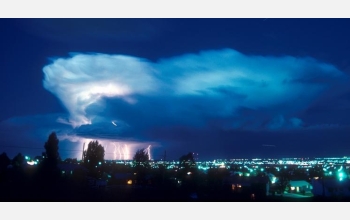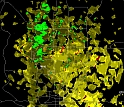News Release 06-110
Forecast: Showers and Thunderstorms
Scientists add measure of low-level moisture to the prediction toolbox

Measuring low-level moisture may help forecasters pin down the location and timing of storms.
August 1, 2006
This material is available primarily for archival purposes. Telephone numbers or other contact information may be out of date; please see current contact information at media contacts.
People planning baseball games, picnics, and other outdoor events may have more precise short-term forecasts of rainfall in the next few years, thanks to an observing strategy now being tested by atmospheric scientists at the National Center for Atmospheric Research (NCAR) in Boulder, Colo.
The effort, nicknamed REFRACTT (refractivity experiment for H2O research and collaborative operational technology transfer), is for the first time using multiple Doppler weather radars to track water vapor in the lower atmosphere. Measuring the low-level moisture is expected to help forecasters pin down the location and timing of storms that might rage a few minutes to a few hours later.
Along with the four radars, the project is using computer models, satellites, special launches of weather balloons known as radiosondes, and moisture sensors that intercept Global Positioning System (GPS) signals.
"REFRACTT extends the application of refraction of radio waves, and has the potential for completely transforming the accuracy of short-term weather forecasts," said Cliff Jacobs of NSF's Division of Atmospheric Sciences, which funded the project that began on June 5 and wraps up on Aug. 11.
Scientists are measuring how refraction--the bending of light as it passes through different substances, in this case, air and water--changes the speed of radar signals. That in turn reveals the presence or absence of atmospheric moisture.If it proves successful, the technique could be added in the next few years to the national network of Doppler radars operated by the National Weather Service (NWS), the researchers say.
"Nobody's ever seen such high-resolution data on moisture before. We believe this could greatly help forecasters predict where heavy rains might develop," said Rita Roberts, NCAR's lead scientist on REFRACTT.
Currently, NWS radars detect rainfall and winds but not water vapor.And because weather stations and weather-balloon launches are often separated by 50-100 miles or more, there is no regular monitoring of low-level moisture between surface stations. Strong contrasts in the amount of moisture often help to spawn intense storms, but the exact location of these differences is often hard to identify before storms develop.
When meteorologists use Doppler radar to track storms, they normally monitor signals that strike raindrops, hailstones, or snowflakes and bounce back toward the radar. The strength of the returning signals indicate the intensity of rain, hail, or snow, while the change in signal frequency reveals information about wind speed.
REFRACTT scientists are using fixed targets such as power lines and silos to see how much the radar signal is sped up or slowed down by variations in water vapor.
Forecasters at the Denver NWS office have used REFRACTT data this summer to monitor weather across northeast Colorado, including the risk of weak tornadoes that often spin up east of the Front Range.
-NSF-
-
A thunderstorm covers the area north of Boulder, Colo.
Credit and Larger Version
Media Contacts
Cheryl Dybas, NSF, (703) 292-7734, email: cdybas@nsf.gov
David Hosansky, NCAR, (303) 497-8611, email: hosansky@ucar.edu
Related Websites
REFRACTT: http://www.atd.ucar.edu/projects/refractt/
The U.S. National Science Foundation propels the nation forward by advancing fundamental research in all fields of science and engineering. NSF supports research and people by providing facilities, instruments and funding to support their ingenuity and sustain the U.S. as a global leader in research and innovation. With a fiscal year 2023 budget of $9.5 billion, NSF funds reach all 50 states through grants to nearly 2,000 colleges, universities and institutions. Each year, NSF receives more than 40,000 competitive proposals and makes about 11,000 new awards. Those awards include support for cooperative research with industry, Arctic and Antarctic research and operations, and U.S. participation in international scientific efforts.
Connect with us online
NSF website: nsf.gov
NSF News: nsf.gov/news
For News Media: nsf.gov/news/newsroom
Statistics: nsf.gov/statistics/
Awards database: nsf.gov/awardsearch/
Follow us on social
Twitter: twitter.com/NSF
Facebook: facebook.com/US.NSF
Instagram: instagram.com/nsfgov



